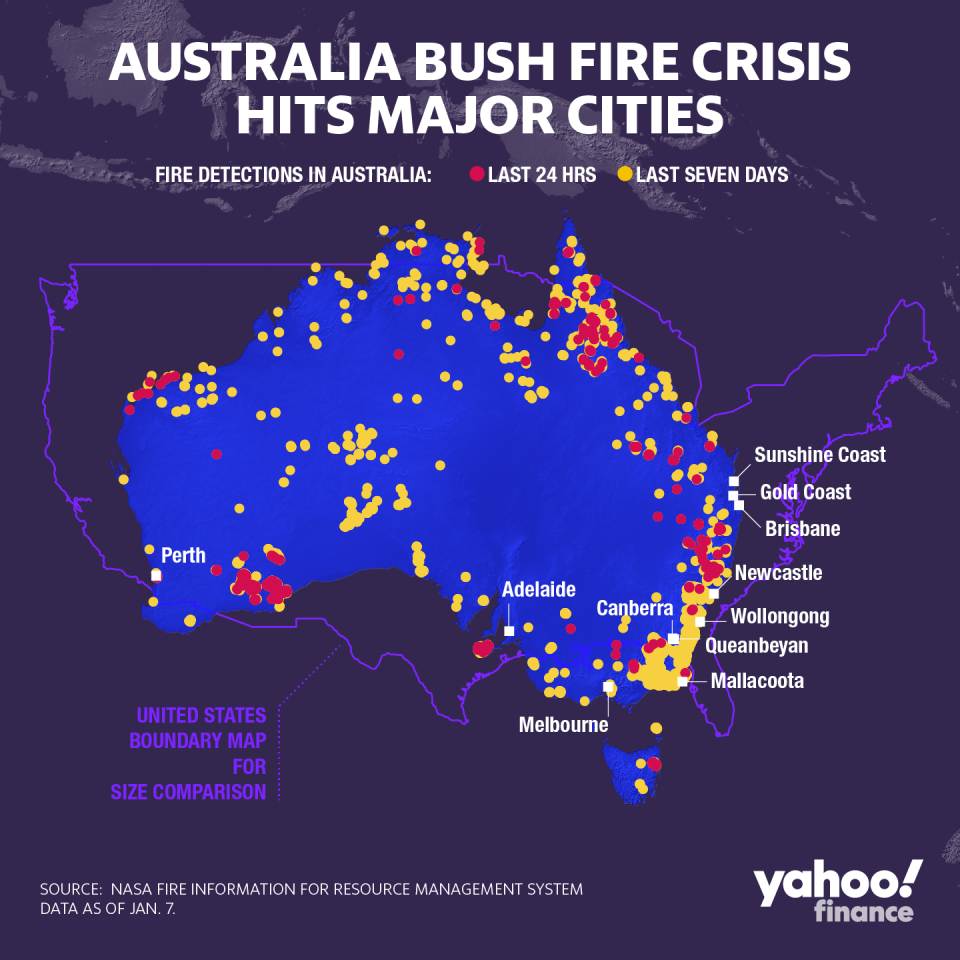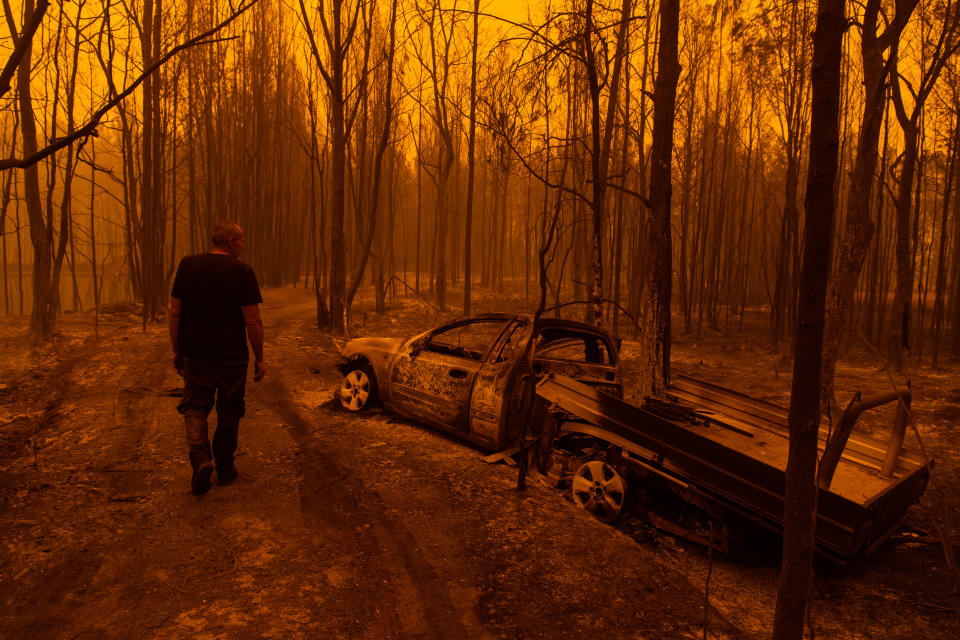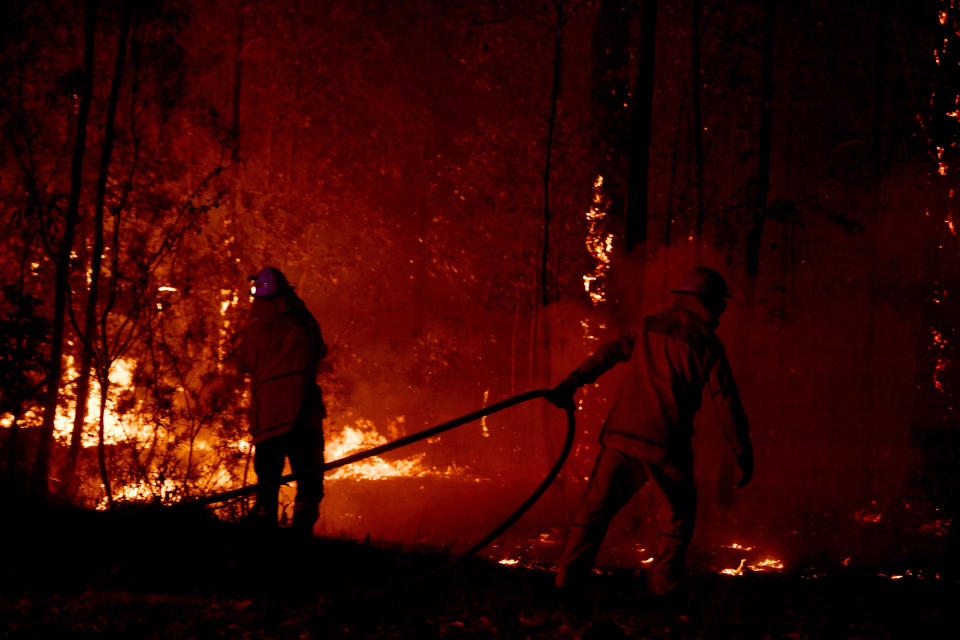Australia bush fires: Historic crisis will cost billions
Australia has been burning since September as more than 19.8 million acres of bush, forest, and parks caught fire amid a long and deep drought.
While the country experienced better weather this week, officials have warned that dangerous weather was expected to come back.
Based on data from NASA satellites over the last seven days, the map below shows how the fires have spread across the country (and the land mass comparison to the U.S.):

Australia’s “fire season” began in the states of Queensland and New South Wales in September last year, fueled by a long drought. At least 25 people have died in the fires thus far, and the New South Wales Police Force have taken legal action against 183 people for fire-related offense (with 24 people charged for allegedly lighting fires deliberately).
Billions in losses for Australia
No matter what happens next, the Australian economy is expected to take a substantial hit from the fires, economists told Yahoo Finance, projecting the damages to reduce GDP in the billions.
“The impact of the bush fires will reduce Australian 2019-20 GDP by between $2.1 billion and $4.3 billion,” Terry Rawnsley, national lead economics and social analysis at SGS Economics and Planning, told Yahoo Finance. “This is the result of lost consumer spending, loss of agricultural production, loss of work days... as people can’t reach their place of work and increased sick leave due to smoke haze in Sydney, Melbourne and Canberra.”

Rawnsley’s estimates suggest that the negative hit to Australia’s GDP growth was between 0.1 and 0.25 percentage points.
Shane Oliver, head of investment strategy at AMP Capital, expected an even bigger hit: “Our base case estimate is that it will knock around 0.4% off Australian GDP in the December and March [quarters] given disruption to agriculture and economic activity generally in the affected areas, tourism, consumer spending via lower confidence.”
Economists expect easing, and rebound in later half of the year
Andrew Ticehurst, senior economist and rate strategist at Nomura Australia, agreed that the impact of the bush fires on GDP is a net negative: “In the near term it would seem sensible to think about weaker activity … particularly given that the fires are still burning, and the sky is full of smoke, even in Sydney.”
He added that parts of Australia’s agricultural industry in particular could experience “modest upward pressure” in inflation due to higher dairy and food prices, as well as a rise in insurance premiums.
At the same time, Ticehurst noted, the projected decline in GDP will likely be supplemented by “replacing lost assets.” For instance, he expects the national and state governments to ramp up spending to address the damages from the bush fires. “In the longer term, there will be a rise in dwelling construction and infrastructure spending as rebuilding comes through,” he added.

Rawnsley agreed, adding that reconstruction efforts will result in a “positive impact” on GDP in 2020-21. Oliver also noted that this “adds to the case for more monetary and fiscal stimulus in Australia.”
And on a more general scale, given the size and scale of the destruction caused by the fires, the economists also expected more pressure on the government to address climate change in Australia.
“Climate change is likely to become an even bigger deal in the minds of the average voter, and this could potentially impact the probability of successful approval of future coal versus renewable energy projects,” Ticehurst said.
Aarthi is a reporter for Yahoo Finance. She can be reached at aarthi@yahoofinance.com. Follow her on Twitter @aarthiswami.
Read more:
The UN is in financial distress, and the US still owes $491 million for 2019
Read the latest financial and business news from Yahoo Finance
Follow Yahoo Finance on Twitter, Facebook, Instagram, Flipboard, SmartNews, LinkedIn, YouTube, and reddit.


